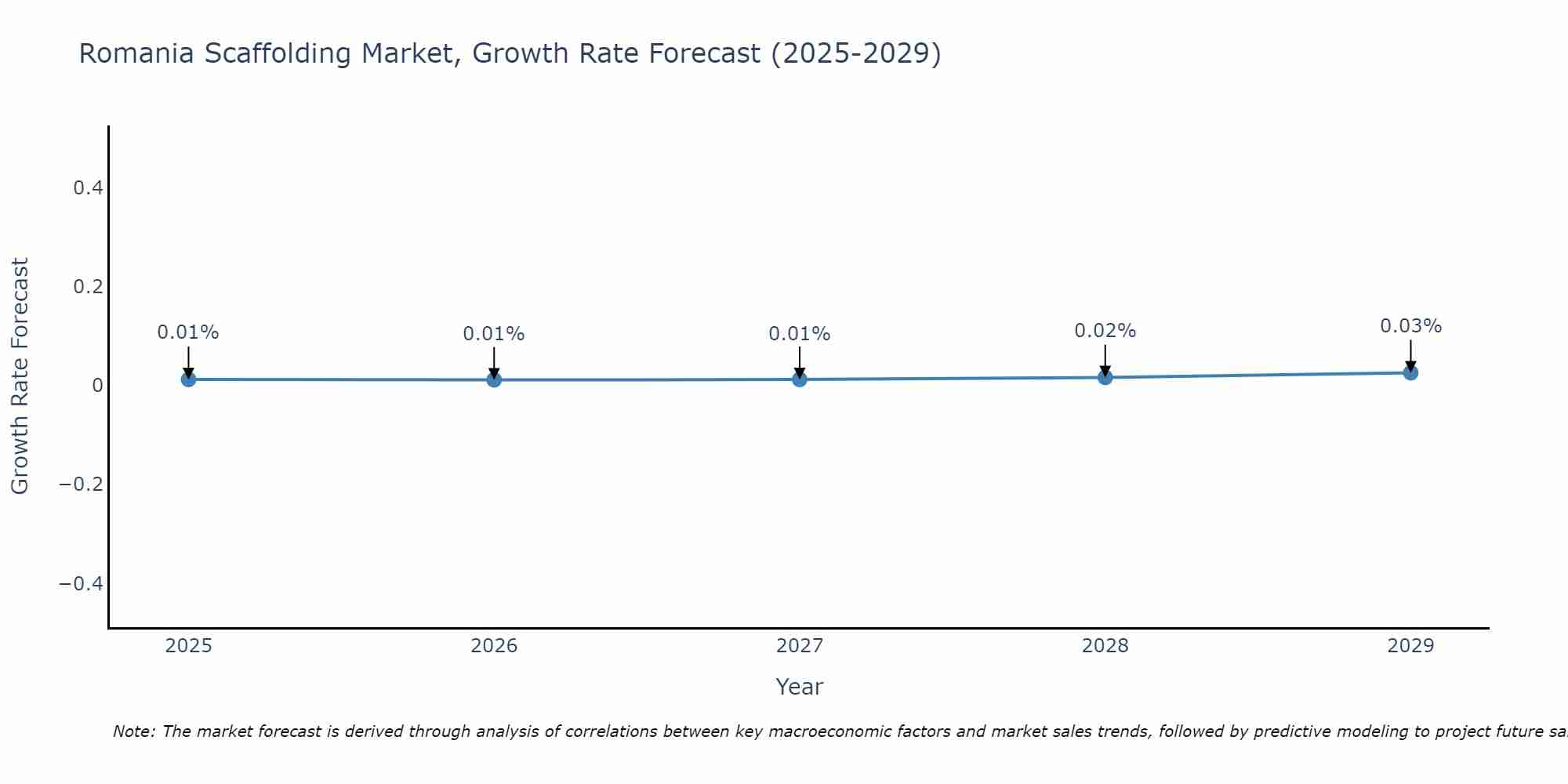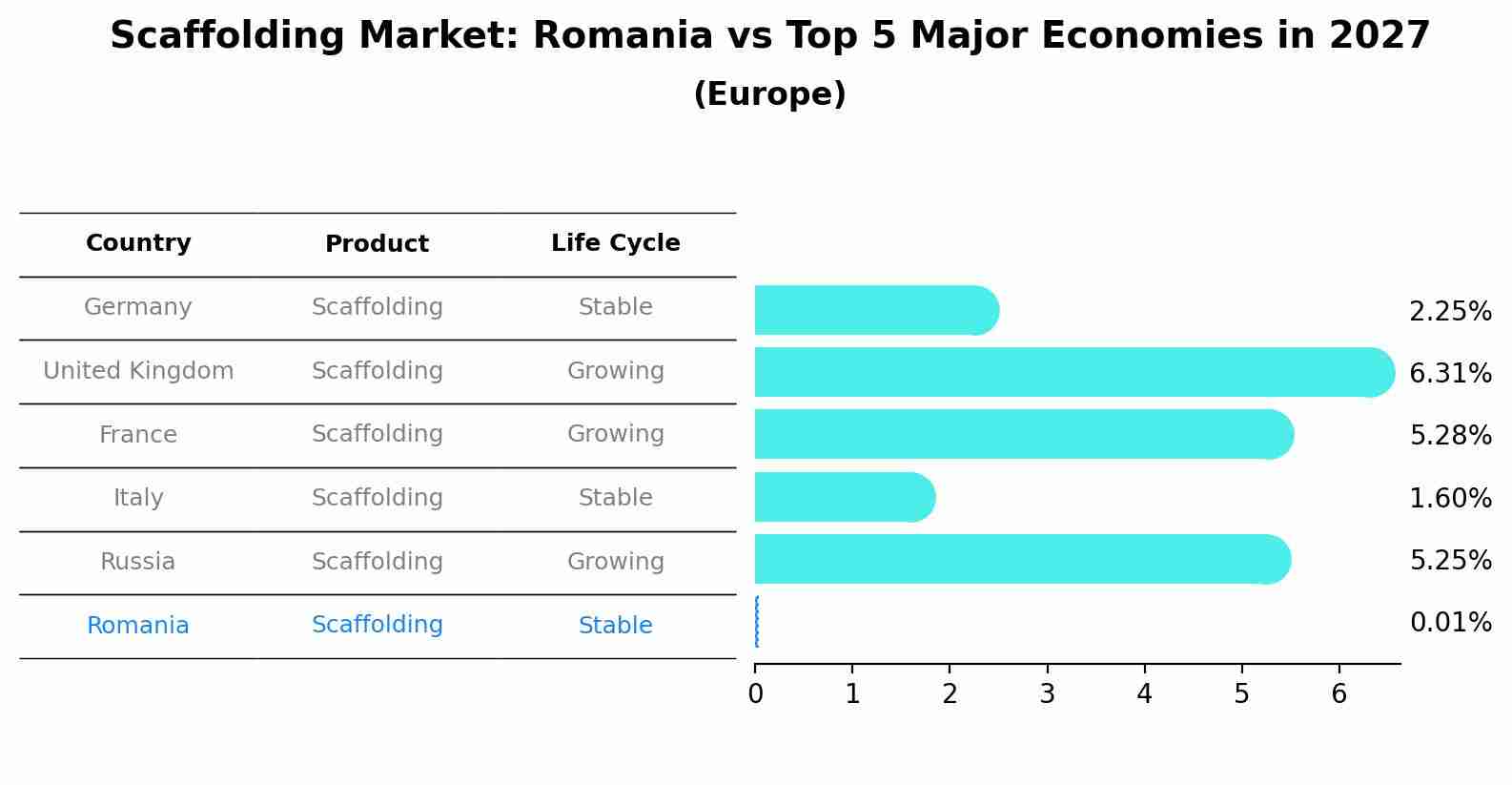Romania Scaffolding Market Outlook | Share, Trends, Forecast, COVID-19 IMPACT, Revenue, Size, Growth, Analysis, Value, Industry & Companies
| Product Code: ETC377778 | Publication Date: Aug 2022 | Updated Date: Jul 2025 | Product Type: Market Research Report | |
| Publisher: 6Wresearch | Author: Summon Dutta | No. of Pages: 75 | No. of Figures: 35 | No. of Tables: 20 |
Romania Scaffolding Market Size Growth Rate
The Romania Scaffolding Market is projected to witness mixed growth rate patterns during 2025 to 2029. Commencing at 0.01% in 2025, growth builds up to 0.03% by 2029.

Scaffolding Market: Romania vs Top 5 Major Economies in 2027 (Europe)
The Scaffolding market in Romania is projected to grow at a stable growth rate of 0.01% by 2027, within the Europe region led by Germany, along with other countries like United Kingdom, France, Italy and Russia, collectively shaping a dynamic and evolving market environment driven by innovation and increasing adoption of emerging technologies.

Romania Scaffolding Market Synopsis
The Romania scaffolding market is experiencing steady growth due to increasing construction activities in the country. The demand for scaffolding is driven by infrastructure development, residential construction, and commercial building projects. The market is characterized by a mix of local and international scaffolding companies offering a variety of products such as steel, aluminum, and wooden scaffolding. Safety regulations and standards are becoming increasingly stringent, leading to the adoption of advanced scaffolding systems that ensure worker safety and efficiency on construction sites. The market is competitive, with players focusing on product innovation, quality, and cost-effectiveness to gain a competitive edge. Overall, the Romania scaffolding market is poised for continued growth as the construction industry expands and modernizes.
Romania Scaffolding Market Trends
The Romania scaffolding market is witnessing several key trends. Firstly, there is a growing demand for advanced and innovative scaffolding systems that offer increased safety and efficiency on construction sites. Companies are increasingly investing in lightweight and easily transportable scaffolding solutions to enhance productivity. Additionally, there is a rising focus on sustainable and eco-friendly scaffolding materials to align with environmental regulations and reduce the carbon footprint of construction projects. The market is also seeing a shift towards digitalization, with the adoption of technologies such as Building Information Modeling (BIM) to streamline design and planning processes. Overall, the Romania scaffolding market is evolving towards more sophisticated, safer, and sustainable solutions to meet the demands of the construction industry.
Romania Scaffolding Market Challenges
The Romania scaffolding market faces several challenges, including a lack of standardization in safety regulations and practices, which can lead to inconsistencies in quality and safety across different projects. Additionally, the industry is impacted by the fluctuating economic conditions in the country, affecting construction activities and investment in infrastructure projects. Competition from alternative construction methods, such as prefabrication and modular construction, also poses a challenge to the traditional scaffolding market. Furthermore, the need for skilled labor and trained scaffolding professionals remains a pressing issue, as the industry requires specialized knowledge and expertise to ensure safe and efficient scaffolding operations. Overall, addressing these challenges will be crucial for the sustainable growth and development of the scaffolding market in Romania.
Romania Scaffolding Market Investment Opportunities
The Romania scaffolding market presents several investment opportunities due to the country`s growing construction industry. With increasing infrastructure development, renovation projects, and urbanization, there is a rising demand for scaffolding solutions. Investors can explore opportunities in supplying a wide range of scaffolding products, including steel, aluminum, and modular systems. Additionally, there is potential for rental services to cater to construction companies looking to reduce costs and maximize efficiency. Investing in innovative and environmentally friendly scaffolding solutions could also be a strategic move to differentiate in the market. Overall, the Romania scaffolding market offers prospects for growth and profitability, especially for companies that can offer high-quality products and services tailored to the evolving needs of the construction sector.
Jordan Agar Market Government Policies
In Romania, the scaffolding market is regulated by various government policies aimed at ensuring safety and quality standards. The main regulatory framework governing the industry includes the Building Law, which sets out requirements for the design, construction, and use of scaffolding structures to ensure they are safe and compliant with building codes. Additionally, the Labor Code mandates strict safety measures for workers using scaffolding, such as training requirements and regular inspections. The Ministry of Labor and Social Justice oversees the enforcement of these regulations through inspections and penalties for non-compliance. Overall, the Romanian government`s policies in the scaffolding market prioritize safety, quality, and compliance with industry standards to protect workers and the public.
Romania Scaffolding Market Future Outlook
The Romania scaffolding market is expected to witness moderate growth in the coming years, driven by increasing construction activities in both residential and commercial sectors. Factors such as government investments in infrastructure projects, urbanization, and growing demand for renovation and restoration projects are likely to fuel the demand for scaffolding systems. Additionally, the adoption of advanced construction techniques and safety regulations will further contribute to market growth. However, challenges such as fluctuating raw material prices and the impact of the COVID-19 pandemic may hinder market expansion. Overall, the Romania scaffolding market is projected to show steady growth in the forecast period, with opportunities for market players to innovate and offer cost-effective and sustainable solutions to meet the evolving needs of the construction industry.
Key Highlights of the Report:
- Romania Scaffolding Market Outlook
- Market Size of Romania Scaffolding Market, 2021
- Forecast of Romania Scaffolding Market, 2031
- Historical Data and Forecast of Romania Scaffolding Revenues & Volume for the Period 2018 - 2031
- Romania Scaffolding Market Trend Evolution
- Romania Scaffolding Market Drivers and Challenges
- Romania Scaffolding Price Trends
- Romania Scaffolding Porter's Five Forces
- Romania Scaffolding Industry Life Cycle
- Historical Data and Forecast of Romania Scaffolding Market Revenues & Volume By Type for the Period 2018 - 2031
- Historical Data and Forecast of Romania Scaffolding Market Revenues & Volume By Supported Scaffolding for the Period 2018 - 2031
- Historical Data and Forecast of Romania Scaffolding Market Revenues & Volume By Suspended Scaffolding for the Period 2018 - 2031
- Historical Data and Forecast of Romania Scaffolding Market Revenues & Volume By Rolling Scaffolding for the Period 2018 - 2031
- Historical Data and Forecast of Romania Scaffolding Market Revenues & Volume By Material for the Period 2018 - 2031
- Historical Data and Forecast of Romania Scaffolding Market Revenues & Volume By Aluminum for the Period 2018 - 2031
- Historical Data and Forecast of Romania Scaffolding Market Revenues & Volume By Wood for the Period 2018 - 2031
- Historical Data and Forecast of Romania Scaffolding Market Revenues & Volume By Steel for the Period 2018 - 2031
- Historical Data and Forecast of Romania Scaffolding Market Revenues & Volume By End User for the Period 2018 - 2031
- Historical Data and Forecast of Romania Scaffolding Market Revenues & Volume By Residential for the Period 2018 - 2031
- Historical Data and Forecast of Romania Scaffolding Market Revenues & Volume By Commercial for the Period 2018 - 2031
- Historical Data and Forecast of Romania Scaffolding Market Revenues & Volume By Industrial for the Period 2018 - 2031
- Romania Scaffolding Import Export Trade Statistics
- Market Opportunity Assessment By Type
- Market Opportunity Assessment By Material
- Market Opportunity Assessment By End User
- Romania Scaffolding Top Companies Market Share
- Romania Scaffolding Competitive Benchmarking By Technical and Operational Parameters
- Romania Scaffolding Company Profiles
- Romania Scaffolding Key Strategic Recommendations
Frequently Asked Questions About the Market Study (FAQs):
- Single User License$ 1,995
- Department License$ 2,400
- Site License$ 3,120
- Global License$ 3,795
Search
Thought Leadership and Analyst Meet
Our Clients
Related Reports
- Canada Oil and Gas Market (2026-2032) | Share, Segmentation, Value, Industry, Trends, Forecast, Analysis, Size & Revenue, Growth, Competitive Landscape, Outlook, Companies
- Germany Breakfast Food Market (2026-2032) | Industry, Share, Growth, Size, Companies, Value, Analysis, Revenue, Trends, Forecast & Outlook
- Australia Briquette Market (2025-2031) | Growth, Size, Revenue, Forecast, Analysis, Trends, Value, Share, Industry & Companies
- Vietnam System Integrator Market (2025-2031) | Size, Companies, Analysis, Industry, Value, Forecast, Growth, Trends, Revenue & Share
- ASEAN and Thailand Brain Health Supplements Market (2025-2031) | Strategy, Consumer Insights, Analysis, Investment Trends, Opportunities, Growth, Size, Share, Industry, Revenue, Segments, Value, Segmentation, Supply, Forecast, Restraints, Outlook, Competition, Drivers, Trends, Demand, Pricing Analysis, Competitive, Strategic Insights, Companies, Challenges
- ASEAN Bearings Market (2025-2031) | Strategy, Consumer Insights, Analysis, Investment Trends, Opportunities, Growth, Size, Share, Industry, Revenue, Segments, Value, Segmentation, Supply, Forecast, Restraints, Outlook, Competition, Drivers, Trends, Demand, Pricing Analysis, Competitive, Strategic Insights, Companies, Challenges
- Europe Flooring Market (2025-2031) | Outlook, Share, Industry, Trends, Forecast, Companies, Revenue, Size, Analysis, Growth & Value
- Saudi Arabia Manlift Market (2025-2031) | Outlook, Size, Growth, Trends, Companies, Industry, Revenue, Value, Share, Forecast & Analysis
- Uganda Excavator, Crane, and Wheel Loaders Market (2025-2031) | Strategy, Consumer Insights, Analysis, Investment Trends, Opportunities, Growth, Size, Share, Industry, Revenue, Segments, Value, Segmentation, Supply, Forecast, Restraints, Outlook, Competition, Drivers, Trends, Demand, Pricing Analysis, Competitive, Strategic Insights, Companies, Challenges
- Rwanda Excavator, Crane, and Wheel Loaders Market (2025-2031) | Strategy, Consumer Insights, Analysis, Investment Trends, Opportunities, Growth, Size, Share, Industry, Revenue, Segments, Value, Segmentation, Supply, Forecast, Restraints, Outlook, Competition, Drivers, Trends, Demand, Pricing Analysis, Competitive, Strategic Insights, Companies, Challenges
Industry Events and Analyst Meet
Whitepaper
- Middle East & Africa Commercial Security Market Click here to view more.
- Middle East & Africa Fire Safety Systems & Equipment Market Click here to view more.
- GCC Drone Market Click here to view more.
- Middle East Lighting Fixture Market Click here to view more.
- GCC Physical & Perimeter Security Market Click here to view more.
6WResearch In News
- Doha a strategic location for EV manufacturing hub: IPA Qatar
- Demand for luxury TVs surging in the GCC, says Samsung
- Empowering Growth: The Thriving Journey of Bangladesh’s Cable Industry
- Demand for luxury TVs surging in the GCC, says Samsung
- Video call with a traditional healer? Once unthinkable, it’s now common in South Africa
- Intelligent Buildings To Smooth GCC’s Path To Net Zero


















